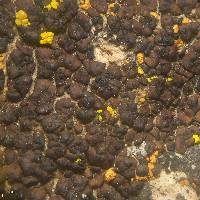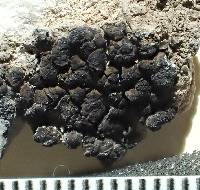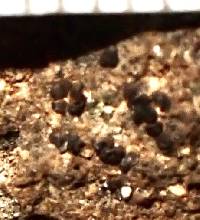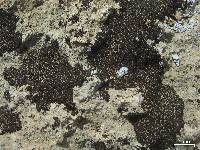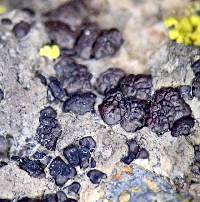
Consortium of Lichen Herbaria
- building a Global Consortium of Bryophytes and Lichens as keystones of cryptobiotic communities -
- Home
- Search
- Images
- Species Checklists
- US States: O-Z >
- US National Parks
- Central America
- South America
- US National Parks
- Southern Subpolar Region
|
|
|
|
Family: Verrucariaceae
[Catapyrenium acarosporoides (Zahlbr.) J.W. Thomson, moreDermatocarpon acarosporoides Zahlbr., Dermatocarpon novomexicanum (B. de Lesd.) Zahlbr., Endopyrenium bajadanae B. de Lesd., Endopyrenium novomexicanum B. de Lesd., Heteroplacidium acarosporoides (Zahlbr.) Breuss] |
Nash, T.H., Ryan, B.D., Gries, C., Bungartz, F., (eds.) 2002. Lichen Flora of the Greater Sonoran Desert Region. Vol 1. Thallus: squamulose squamules: ± convex to almost bullate, rounded to slightly lobed, each with a central peduncle, up to 2 mm wide and 0.7 mm thick (including the central peduncle), discrete or (mostly) contiguous (thus forming an areolate-appearing thallus) upper surface: dark brown to red brown, smooth, matt or glossy upper cortex: 40-60 µm thick medulla: white, nearly prosoplectenchymatous, with a varying number of globose cells (in thick squamules distinctly filamentous); algal layer: c. 70-100 µm high lower cortex: indistinctly developed or lacking, composed of ± loosely arranged globular cells (9-12 µm in diam.), brownish below lower surface: brownish; rhizohyphae: hyaline, confined to the central pedunculate area Perithecia: few per squamule, subglobose, up to 0.4 mm wide; exciple: colorless except for the apex; periphyses: short (up to 30 µm) asci: primarily cylindrical, later becoming narrowly clavate, 55-60 x 20 µm ascospores: uniseriate at early stages, then subbiseriate, broadly ellipsoid, c. 13-17 x 8-11 µm Pycnidia: laminal, immersed conidia: oblong to shortly cylindrical, 3-5 (-6) x 1 µm Spot tests: all negative Secondary metabolites: none detected. Substrate and ecology: granitic rocks and sandstone on open dry sites World distribution: SW North America, Chile, South Africa Sonoran distribution: fairly common in Arizona, California, Baja California and Baja California Sur. Notes: This is a characteristic species with ± glossy brown, ± convex squamules and broadly ellipsoid spores. The hyphal construction of the medulla varies somewhat; the medulla of the thickest squamules is distinctly filamentous at least partially, especially in the central parts. Globular cells occur in varying numbers and may dominate in thin squamules especially of poorly developed material. The asci tend to be clavate such that the species was included in Heteroplacidium by Breuss (1996). However, they are distinctly cylindrical at an early stage. The complex thallus anatomy also is characteristic of Placidium. A close relative with narrowly ellipsoid spores is P. lesdainii. |
|
|
|
Powered by Symbiota



